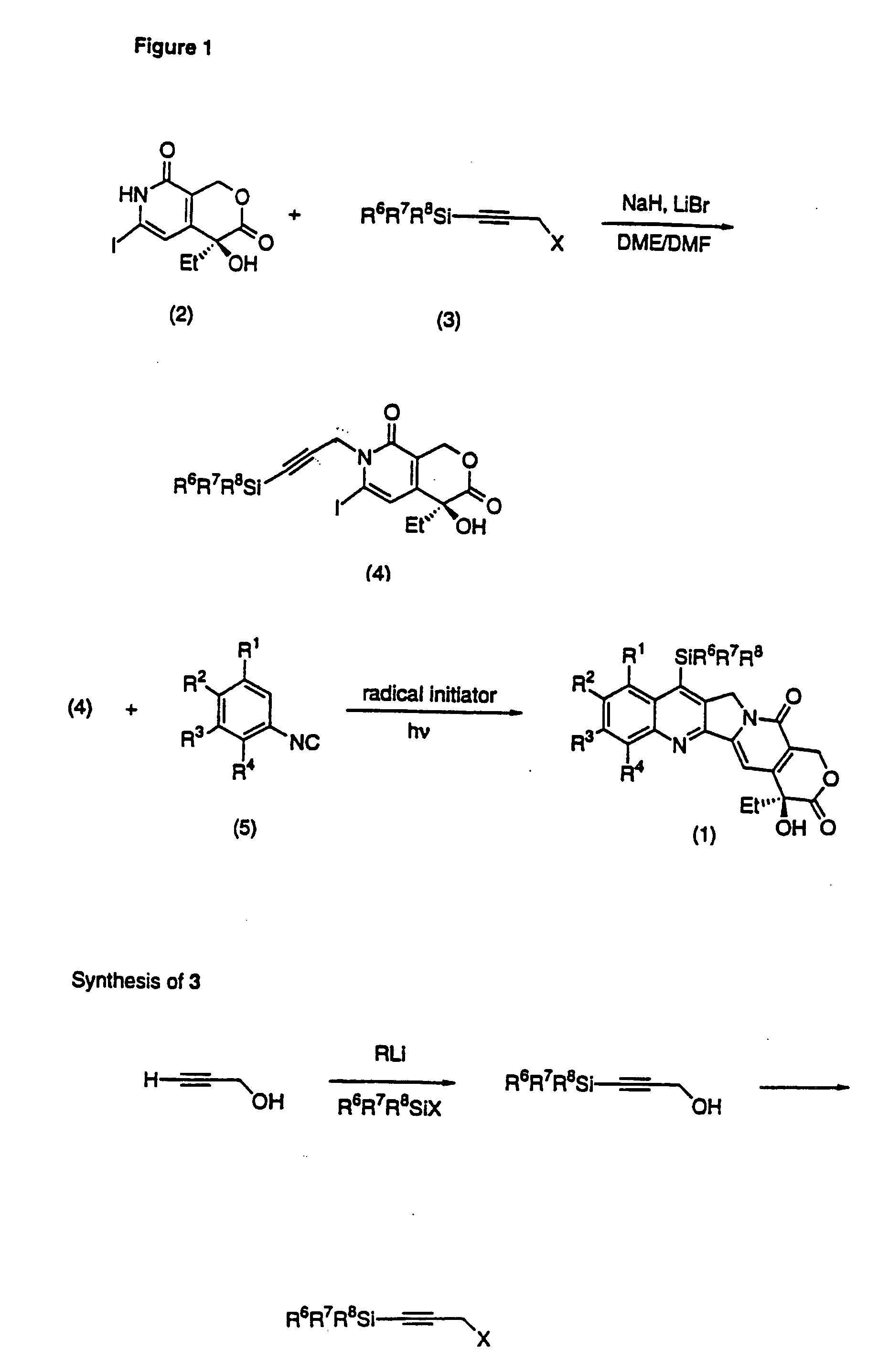Camptothecin analogs and methods of preparation thereof
a technology of camptothecin and analogs, applied in the field of compounds, can solve the problems of limited initial clinical trials of camptothecin, cascade of events, apoptosis and programmed death,
- Summary
- Abstract
- Description
- Claims
- Application Information
AI Technical Summary
Benefits of technology
Problems solved by technology
Method used
Image
Examples
example 1
Preparation of (20S)-7-trimethylsilylcamptothecin
[0056]
(1) (S)-4-Ethyl-4-hydroxy-6-iodo-3-oxo-7-(3-trimethylsilyl-2-propynyl)-1H-pyrano[3,4-c]-8-pyridone
[0057] To a solution of (S)-4-ethyl-4-hydroxy-6-iodo-3-oxo-1H-pyrano[3,4-c]-8-pyridone [iodopyridone (2), 250 mg, 0.746 mmol] in DME (2.5 mL) and DMF (0.60 mL) at 0° C. under argon was added 60% NaH in mineral oil (31.3 mg, 0.783 mmol). LiBr (150 mg, 1.75 mmol) was added 10 min latter. After 15 min at room temperature, 3-trimethylsilyl-2-propynyl bromide (430 mg, 2.24 mmol) was injected and the reaction mixture was heated in the dark at 65° C. for 20 h. The final solution was poured into brine (20 mL), extracted with AcOEt (6×15 mL) and dried (Na2SO4). The residue obtained after removal of the solvents was subjected to flash-chromatography (CHCl3 / AcOEt 95:5) to give 283 mg (85%) of a foam: [α]20D +36.7 (c 1, CHCl3); IR (neat, cm−1) 3384, 2940, 2166, 1730, 1634, 1518, 1406, 1130, 841, 752; 1H NMR (300 MHz, CDCl3) δ 0.14 (s, 9H), 0....
example 2
Preparation of (20S)-7-tert-butyldimethylsilylcamptothecin
[0059]
(1) (S)-4-Ethyl-4-hydroxy-6-iodo-3-oxo-7-(3-tert-butyldimethylsilyl-2-propynyl)-1H-pyrano[3,4-c]-8-pyridone
[0060] Following the procedure described in Example 1-(1), iodopyridone (2) (200 mg, 0.60 mmol) and 3-tert-butyldimethylsilyl-2-propynyl bromide (280 mg, 1.20 mmol) provided, after flash-chromatography (CH2Cl2 / AcOEt 9:1), 173 mg (59%) of a white foam: [α]20D +58 (c 0.2, CHCl3); IR (CHCl3, cm−1) 3548, 2950, 2927, 2859, 1745, 1648, 1526; 1H NMR (300 MHz, CDCl3) δ 0.08 (s, 6H), 0.92 (m, 12H), 1.79 (m, 2H), 3.77 (br s, 1H), 5.00-5.25 (m, 3H), 5.50 (d, J=16.4 Hz, 1H) 7.19 (s, 1H); 13C NMR (75 MHz, CDCl3) δ−4.9, 7.63, 16.6, 26.0, 31.6, 44.5, 66.3, 71.8, 89.4, 98.6, 100.0, 116.5, 118.1, 148.6, 158.0, 173.2; HRMS (EI) m / z calcd for C19H26INO4Si (M+) 487.0679, found 487.0676; LRMS (EI) m / z 487 (M+), 430, 386, 96, 81, 57.
(2) (20S)-7-tert-butyldimethylsilylcamptothecin
[0061] Following the procedure described in Example 1-...
example 3
Preparation of (20S)-7-tert-butyldiphenylsilylcamptothecin
[0062]
(1) (S)-4-Ethyl-4-hydroxy-6-iodo-3-oxo-7-(3-tert-butyldiphenylsilyl-2-propynyl)-1H-pyrano[3,4-c]-8-pyridone
[0063] Following the procedure described in Example 1-(1), iodopyridone (2) (200 mg, 0.60 mmol) and 3-tert-butyldiphenylsilyl-2-propynyl bromide (428 mg, 1.20 mmol) provided, after flash-chromatography (CH2Cl2 / AcOEt 9:1), 258 mg (70%) of a white foam: [α]20D +45.1 (c 0.2, CHCl3); IR (CHCl3, cm−1) 3546, 2928, 2855, 1741, 1658, 1526; 1H NMR (300 MHz, CDCl3) δ 0.97 (t, J=7.3 Hz, 3H), 1.08 (s, 9H), 1.80 (m, J=7.1 Hz, 2H), 3.76 (br s, 1H), 5.13 (d, J=16.4 Hz, 1H), 5.29 (d, J=2.5 Hz, 2H), 5.52 (d, J=16.4 Hz, 1H), 7.22 (s, 1H), 7.32-7.40 (m, 6H), 7.76-7.78 (m, 4H); 13C NMR (75 MHz, CDCl3) δ 7.6, 18.6, 27.0, 31.6, 44.6, 60.4, 66.3, 71.8, 86.5, 99.9, 102.2, 116.6, 127.7, 129.6, 132.6, 135.6, 148.7, 157.8, 173.2; HRMS (EI) m / z calcd for C25H21INO4Si (M-C4H9+) 554.0279, found 554.0285; LRMS (EI) m / z 554 (M-C4H9+), 587, 510,...
PUM
| Property | Measurement | Unit |
|---|---|---|
| body weight | aaaaa | aaaaa |
| body weight | aaaaa | aaaaa |
| temperature | aaaaa | aaaaa |
Abstract
Description
Claims
Application Information
 Login to View More
Login to View More - R&D
- Intellectual Property
- Life Sciences
- Materials
- Tech Scout
- Unparalleled Data Quality
- Higher Quality Content
- 60% Fewer Hallucinations
Browse by: Latest US Patents, China's latest patents, Technical Efficacy Thesaurus, Application Domain, Technology Topic, Popular Technical Reports.
© 2025 PatSnap. All rights reserved.Legal|Privacy policy|Modern Slavery Act Transparency Statement|Sitemap|About US| Contact US: help@patsnap.com



